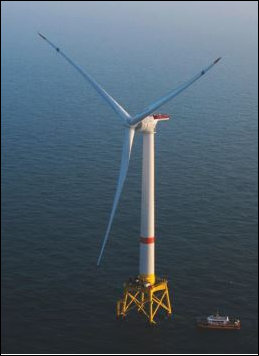by James A. Bacon
Judging from comments made in a Environment Virginia-sponsored webinar held this morning, environmentalists, the McAuliffe administration and Dominion Virginia Power are operating on the same wave length when it comes to developing offshore wind power in Virginia. If environmental groups have big differences with Dominion on how to proceed, no sign of criticism surfaced in the webinar presentations.
The main focus of environmentalists, as it is for Dominion, is bringing down the cost of offshore wind power. The top priority nationally is building a big enough pipeline of wind power projects off the Atlantic Coast to persuade manufacturers, specialty vessels and others in Europe’s established wind-power supply chain to create a presence on the U.S. East Coast. The existence of a supply chain, along with continued technological development, could make offshore wind power far more cost competitive in the U.S. than it is today.
Here in Virginia, the top priority is ensuring that Dominion builds two experimental turbines off Virginia Beach that will provide the data needed to optimize the development of hundreds of wind turbines in a subsequent project potentially large enough to power 700,000 homes. The big hurdle is persuading the State Corporation Commission that such a massive investment would constitute an acceptable trade-off between cost, reliability and environmental goals.
David Carr, general counsel for the Southern Environmental Law Center, provided an overview of Dominion’s offshore wind initiatives. Dominion solicited bids to build a two experimental turbines off the Virginia coast. (The turbines would test an unproven hurricane-resilient design and a new turbine foundation.) The original plan was to seek SCC approval in 2015, said Carr, but the low bid of $375 million to build the two turbines far exceeded the original estimate of $230 million. Dominion has restructured the contract by breaking it into four components in the hope of stimulating more competitive bidding and reducing the risk premiums bidders build into their offers. The new goal is to file with the SCC by June 2016.
Hayes Framme, advisor for infrastructure and development with the Secretariat of Commerce and Trade, said the McAuliffe administration played a key role in moving the Dominion’s experimental-turbines project forward by negotiating a complex lease with the Bureau of Ocean Energy Management and other federal agencies to lease the ocean bottom where the turbines would be located. “Without this lease,” he said, “we would not be able to get these turbines in.”
An offshore wind farm would advance two McAuliffe administration goals: increasing the state’s commitment to renewable energy and also promoting economic development. A study completed this summer found that Virginia is “uniquely positioned” to house “at least a portion, if not most, of the supply chain” supporting an East Coast offshore wind industry, Framme said. Virginia ports are located in the Mid-Atlantic, providing convenient access to projects to the north and south, and it has a large existing ship-repair infrastructure.
“Having a commercial deployment off Virginia’s coast sends a signal that we are serious,” Framme said. “If we don’t lay the foundation now, it will be more difficult for us to take advantage of that opportunity when it does come.”
Virginia’s projects are not sufficiently large by themselves to coax the offshore wind supply chain to bolster its U.S. presence. That will take commitments from multiple states. Fortunately, that commitment seems to be forthcoming, said Stephanie McClellan, director of a special initiative on offshore wind housed at the University of Delaware. The states of New York, Massachusetts, Rhode Island, Maine and Maryland all are actively exploring offshore wind opportunities. The state of New York has set a goal of 50% renewables by 2030, while New York City has established a goal of 100% renewables for electricity consumed by municipal operations.
To build a supporting infrastructure for offshore wind, said McClellan, eastern U.S. states need to provide market visibility and revenue certainty for a volume of projects over time, as well as more data on site-specific conditions such as wind speeds and wave size. The cost of wind power dropped “precipitously” in Europe as the industry gained scale; it will do so in the U.S. as well, she said.
Bacon’s bottom line: I posed one question to the presenters: Given the intermittent nature of wind production, has anyone studied the impact of a massive wind farm on the reliability of Virginia’s electric grid? The short answer: No. However, presenters noted that European countries have integrated large off-shore wind projects into their power grids, and PJM Interconnection, the group that ensures grid reliability in the Mid-Atlantic and parts of the Midwest, including Virginia, has looked into the issue.
Update: Regarding the impact of massive off-shore wind power on the electric grid… a Dominion planning department study published in 2010 concluded, “It is possible to interconnect large scale wind generation facilities up to a total installed capability of 4500 MW with the existing transmission system in the Virginia Beach area. The study also indicates that when the actual output of the wind farm or farms approaches 2700 MW, there are greater probabilities that the output will have to be limited due to transmission constraints unless transmission infrastructure improvement are made.” Those improvements could cost between $30 million and $70 million.



